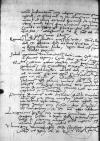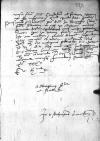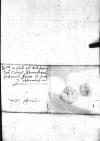Die 1535-01-15⌊XXV-o huius mensis1535-01-15⌋ redditae mihi fuerunt ⌊⌋ Dominationis Vestrae Reverendissimae datae in ⌊castro suo Lubaviensi⌋ 1535-01-04⌊4 Ianuarii1535-01-04⌋, per dominum ⌊Fabianum⌋, qui salvus huc appulit atque hodie, uti existimo, versus ⌊Hispanias⌋ recedit.
Dominationis Vestrae Reverendissimae ⌊⌋ datas 1534-08-04⌊4 Augusti1534-08-04⌋ cum aliis quibusdam annexis accepi similiter. Ego tum illico Reverendissimae Dominationi Vestrae respondi atque indicavi fuisse me in ⌊Hispaniis⌋ per equos dispositos et in reditu invenisse seu advocasse ⌊Ysope⌋, quam rogavi plurimum, ut ⌊Ioannam⌋ ostenderet, quod tam subito fieri non potuit, inquiens illam esse in quodam monasterio, quod idem a ⌊Welsaris⌋ intellexi. Egi satis fideliter cum ⌊Ysope⌋, quo consentiat, ut ⌊filiola⌋ ad Dominationem Vestram veniat, ad quod satis difficilem se praebuit. Tandem conclusit, ut mittantur semel bis centum ducati pro ⌊illius⌋ vitae sustentatione, tum fore contentam, alioquin expressis verbis dixit videlicet: Cogatur filiola mea in senectute de vitae necessitate mihi providere, itaque litteris meis tunc exhortatus Dominatio Vestra Reverendissima, ut omnino citius, quo poterit, cum ⌊Ulrico Ehinger⌋ ordinem instituat, quo filia in ⌊Flandriam⌋ mittatur.
Litteras annexas ad dominum ⌊Cornelium⌋ misi, qui ex ⌊Hispaniis⌋ respondit sub data quinta Novembris easdem recepisse. Quod in hunc diem non respondit Dominationi Vestrae Reverendissimae, miror plurimum. Rediit iam pridem ex ⌊Hispaniis⌋ estque ⌊Bruxellae⌋ apud ⌊uxorem⌋. Ex longo itinere, scribit, nervorum contractionem adeptum esse, itaque domi vivere velle, quoniam a ⌊caesarea maiestate⌋ nihil accepit aliud praeter locum consulis in ⌊Flandria⌋. ⌊Caesarea maiestas⌋ ad me scribit ante dies viginti misisse ad dominum ⌊Cornelium⌋ novam instructionem cum aliquot Germaniae princi[pibus] agendi et quicquid in ea commissione impet[ra]verit, id totum oretenus hic mihi sit relaturu[s], itaque eundem brevi huc venturum existimo. Curabo, ut statim ad priores et istas nunc mis[sas] respondeat. Novissime Dominationis Vestrae Reverendissimae litteras ad eu[m] misi per postas ante biduum.
⌊Reginalis maiestas⌋ in ⌊Flandria⌋ rectissime valet. ⌊Dominus a Nas[sau]⌋ ibidem est. [S]tatuit ibidem residuos dies vitae suae in tranquillitate finire. Uxor illius eum sequet[ur] in Martio proximo.
In dies exspectamus declarationem belli inter ⌊caesaream maiestatem⌋ et ⌊Francorum regem⌋. ⌊Caesar⌋ satis rebus suis provi[detur].
⌊Maiestas caesarea⌋ paravit classem centum triremium, VI[II] galleonum, IIII carachrarum(!) et XXX-ta caravellar[um] contra ⌊Barbarossa⌋. Milites Itali et Hispani ad numerum XIX aut XX milia conscribuntur nunc pro ea classe. Similiter Augustae conscribuntur V milia Germani milites ad eundem usu[m] classis. Cum his militibus erit parata circa decimam mensis Martii, ita ut tum Neptuno se committant.
⌊Pontifex Romanus⌋ vult describere generale concilium liberum etc. per totum mensem Maium, ut ⌊Man[tuae]⌋ aut ⌊Veronae⌋ observetur. Noluit ingredi in ligam ⌊Italiae⌋ cum ⌊caesare⌋, dicit se velle esse neutralem et ita non egere confoederatione.
⌊Lanthgravius Hessiae⌋ cum maxima humilitate impetra[vit] gratiam ⌊caesareae et regiae maiestatum⌋. Pollicitus est nunquam se acturum aliquid, quod ingratum cognoverit futurum ⌊eorum maiestatibus⌋.
⌊Ulricus dux Wirtembergensis⌋ nondum satisfecit tract[atibus] Cadnensi, inter ⌊imperatoriam et Romanorum regiam maiestates⌋ factis. Misit filium suum ⌊Cristopherum⌋ ad ⌊Francorum regem⌋, ut illi inserviat. Quid exinde fiat, ignoro.
Pensionis solutionem pro domino ⌊Ioanne Reinechio⌋ satis fideliter sollicitavi et egi, ut cum primum aulicis pecunia detur, exsoluturos eam mihi polliciti sunt. Hic, ut verum fateor, nulla pecunia est, aut modica, aulicis debentur stipendia XIIII mensium et ultra. Quamprimum illis detur, non ero negligens pro dicto domino doctore. Id Reverendissima Dominatio Vestra illique meo nomine indicare dignabitur, cui me tanquam patri [c]olendissimo ex animo commendo.



